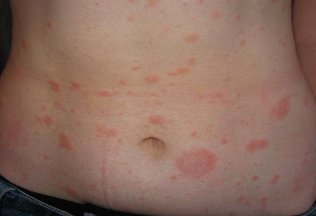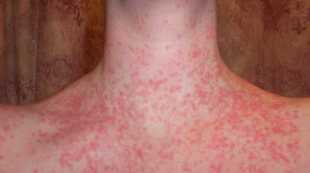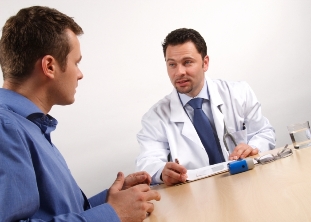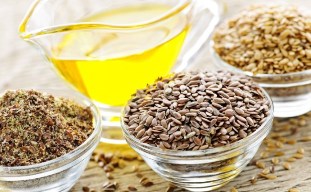
Scientists say that in the last years of the psoriasis in the body is more common than before. The disease is a chronic inflammatory state, accompanied by important lesions of the skin red rash in the form of plaques and papules. Unfortunately, completely to get rid of the disease can not be. Set up a time, the disease pursues a man with a life, periodically burning with new strength. How to treat psoriasis in the body, and what tools to use to consider in detail.
Function of the pathology is its specificity and the fact that each patient's psoriasis is manifested in different ways. Often causes rashes remain outstanding, and all that is left to do that doctors can focus on the maximum reduction of the symptoms of the disease.
What is psoriasis and why it occurs
The disease refers to non-communicable diseases related to cutaneous dermatosis. Due to various circumstances, the person can interrupt the normal process of skin cell division. A person in normal condition, the update of the layer of the dermis takes place over 25-30 days. In psoriasis, this period can be reduced to 5 days. This process causes the loss of connections between cells of the skin, its roughness, the separation and rejection. To the skin begin to appear, the plaques and papules, are usually bright red or pink color.
The one that appears in the psoriasis in the body? Scientists can not give a final answer to the cause of development of psoriasis. None of the theories is not approved and has not been formally demonstrated. There are only hypotheses, from which we can highlight certain causes of the disease. So, what appears on the psoriasis in the body, to find out more:
- a process metabolic of the dermis and throughout the body;
- unstable hormones. Can occur due to the disruption of the endocrine system;
- hypothermia and frequent infectious disease;
- the weakening of the immune system;
- frequent mechanical damage, as well as the impact of chemical agents;
- often, the rashes can occur on the background of psychosomatic disorders;
- the intake of alcohol and certain drugs, and more.

Stages and symptoms of psoriasis
Manifestations of the disease always depend on the stage of the course of the disease. Next, let us examine the main stages of the disease and characteristic symptoms for each of them.
Progressive stage
The so-called form of the disease with the first manifestation, or to the next exacerbation. This stage is characterized by the emergence of a large number of psoriatic patches that increase in size and are accompanied by severe inflammation. Also present intolerable sense of itching, the skin hurt to take off. The patient experiences severe discomfort.
Phase of treatment in hospital
Here the plates are formed with less intensity, but on the cleanliness of the question. The eruption takes the patient all the same discomfort, itching, the skin is irritable and painful. Papules continue to grow and merge into one large lesion. Plates densely covered with white scales.
Stage of regression
Also, in this phase is called phase of healing. The growth of papules is stopped, the skin slowly begins to clear. Leaves redness of the skin, which indicates a decrease of the inflammation. It is very important in the improvement of the status of the patient should not discontinue the treatment. Here all the efforts are aimed at the prevention of recurrence and full recovery of the skin.
Species of the disease — the photo looks like psoriasis on the body
Type of pathology is very. Each one has its own characteristics and severity of the disease. Next, we take into account the main types of psoriasis in the body.
Tabula informibus psoriasis
One of the most common types of the disease. Is located in more than 80% of all patients. The other name vulgaris or psoriasis vulgaris. Typical manifestations is the formation of spots on the body, that protrude above the surface of the skin of a few millimeters. Have a red or pink color and covered with white or gray scales. The affected skin is itchy and easily damaged.
Tear
The lesions are arranged at random in the form of drops. This type can appear on any area of the skin in adults and adolescents. The size of the lesions can be very varied, from the size of a pea, to very large lesions with a diameter of an egg. In the initial phase of the plates may be small, but with the development of the disease and their number increases. Gradually, the rash may cover the whole body.
Inverse (psoriasis flexor surfaces)
Externally psoriatic lesions more smooth than with other types. Peeling in this form is absent or minimally expressed. Location of plaques, mainly in the creases of the skin. Other parts of the body do not suffer. Most often the rash appears in the armpits, in the groin, in women, under the Breasts, on the inner face of the thighs. Exacerbated by the disease of the summer, as there is active sweat glands. The sweat which causes a favorable environment for pathogens.
Pustular
It is the most severe form of the disease. With this form in the patient's body to pop the bubbles with a clear fluid, which protrude above the surface of the skin of a few millimeters. These vesicles, called pustules, hence the name. The skin in places of rash becomes red, swelling and pain. Usually the pustules are localized in the upper and lower extremities in more severe cases, the rash may spread to the whole body, to form a large lesion.
Nail psoriasis
In medical practice this type of call onihodistrofiya. Here affects the nail plate, the distortion and separation of the body of the finger. The disease is spreading to the health of the nails and skin. Improper treatment or the lack of it, the scars remain for life.
Erythrodermic psoriasis
The main symptom is the detachment of skin lesions, a strong roughness of the skin, inflammation of the dermis and its layers. Here also present symptoms such as itching, swelling, peeling, redness and the development of the inflammation.
Often in this form, you may experience blood poisoning, which leads to serious condition of the patient and even death.
Psoriatic arthritis
In addition to the injuries on the body pathology involves inflammation of the joints. A patient has pain in the joints and muscles. Most often in the fingers and lower extremities. Phalanx can increase in size and seemed to swell. Delay in the treatment of the disease often leads to disability.
Basic principles of treatment of psoriasis in the body
So, how to treat psoriasis in the body? Most often the therapy of the disease begins with the application of funds intended for local use. Special medications in the form of ointments, creams, lotions, and sprays applied to the skin in areas of lesions. In the milder forms of the disease, the individual use of the drugs in the more severe forms it is recommended the use of drugs of combined action.
Brown rough skin, doctors recommended to eliminate with a special emollient cream. A ointment for psoriasis in the body it is applied in layers of thickness, it helps to soften the dead skin dermis layer, m the order of removal.
To assign the care of psoriasis on the body and the medicine in pathology doctor needs exclusively. Often the professional of practice-hormonal, non-hormonal ointments and medicines in the composition with vitamin D3.

Along with the treatment with drugs are synthetic, often use methods such as ultrasound treatment. In medical practice this type of treatment is also called light treatment. This procedure is very safe and effective.
Psoriasis of the scalp it is also used medicated shampoos, gels and masks. To deal with the disease line of hair is very difficult, because hair is a barrier to the penetration of the therapeutic components.
The use of drugs
Remedy for psoriasis on the body must be appointed, exclusively for the specialist. Do not self medicate. The patient may confuse psoriasis with other skin disease to treat and is not what you need.
Medications of psoriasis in the body are divided into the following groups:
- Corticosteroids. These funds have a powerful effect, but the big drawback is a lot of side effects. They should be used strictly on prescription.
- Medications with vitamin D3 in the composition. Vitamins are essential in the treatment of this disease. Saturate the body with magnesium, zinc, potassium, helps restore the immune system and promote healing of the skin.
- Tar preparations. This product is included in Soaps, shampoos, ointments and gels. To get rid of the disease, used juniper, pine and birch tar.
Complications of the use of local funds is not enough. In these cases, doctors inject the treatment of phototherapy, laser treatment and other types of physical therapy.
The role of traditional medicine
Next, look at how to treat psoriasis in the body traditional methods. With this purpose, often used ointments are homemade and various tools based on herbs. Consider a few effective recipes, how to treat psoriasis in the body to the home.
Flax seeds for skin cleansing
To prepare the medication must be placed in a thermos 1 l 2 tbsp. l'. flax seeds and Bay with boiling water, close the lid. Infuse the mixture for at least 10 hours. Use dyeing need of morning and afternoon on an empty stomach.

The soda treatment
The affected skin is recommended to wipe 5-6 times a day with a solution of ordinary baking soda. To do it in a glass of warm water should dissolve 2 teaspoons of sodium bicarbonate. In the solution to moisten a pad of cotton with care and handle plate.
Onion poultice
To prepare the medication you need to take the onion and chop it. The mixture resulting wrap in gauze and apply to 20-30 minutes for injuries. Treatment should be continued until the cleaning.
Treatment of psoriasis of the body is a complex and long process. The success can only be achieved through the treatment of your health with due care and the application of the necessary effort.























